While a genetic approach is usually considered a means of introducing a topic (the pupils will meet the topic in the same order as it was developed in history), a hermeneutic approach (as suggested by Jahnke) concerns reading original sources when already having pre-knowledge about the topic concerned.
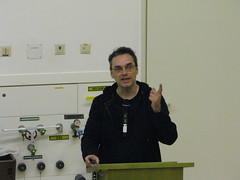

Glaubitz set up three teaching sequences of equal length which were then taught in different groups of students by different teachers. The genetic approach failed miserably, while the hermeneutic approach did significantly better than the conventional approach. Of course, such an experiment can never be a proof of the non-feasibility of an idea, so the results for the genetic approach are not the most interesting ones. However, it is a bit impressive that teachers used to the conventional approach can be guided into teaching successfully with original sources (using the hermeneutic approach) in such a short time. (Although we may of course, as always, have the effect of trying something new.)
To me, this is very promising results. The genetic approach seems too ambitious to me – in a way, you need to take into account all the history of mathematics at the same time, which puts enormous demands on the teachers’ knowledge. The hermeneutic approach delves into one particular point of time and one particular context. While that is certainly also demanding, it seems more like something many teachers could be willing to try – given the right materials.
The second plenary lecture was Raffaele Pisano’s “Which is the cultural and interdisciplinary role played by physical and mathematical sciences? Epistemological Reflections”. This talk concerned the connections between physics and mathematics. To be perfectly honest, I have never had a physics course in my life, and therefore found most of the lecture too advanced for me. (Which doesn’t say much, of course.)

Then there was another panel. The title was “The role of the history and epistemology of mathematics in pre-service teachers training”. The panelists were Evelyne Barbin, Fulvia Furinghetti, Snezana Lawrence and myself. I did not take notes during this panel (except notes on what I was going to say), so I’m not the right person to try to summarize it. However, for me personally, the main outcome of the panel itself and the preparations for it was a realization that it is time that I do something a bit more substantial when it comes to making history of mathematics available to teachers. It’s been ten years since my first HPM conference (in which I complained about the quality of Norwegian textbooks), six years since my second HPM conference (and first ESU) (in which I complained about the quality and quantity of history of mathematics in the TIMSS Video Study materials), three years since my second ESU (in which I did not complain actually – but showed examples of history of mathematics I’ve used in teacher training) and two years since my third HPM (in which I discussed teachers’ conceptions of history of mathematics). Isn’t it time for me to come to a HPM or ESU with a textbook or webpage and discuss why I have created this wonderful book/webpage in this way? Maybe in 2014?
I could mention that my part of the panel discussion was taking Deborah Ball’s model of teacher competence in mathematics as a starting point. My own preparations on this – as well as a question in the discussion – made me realize that I have to revisit Ball’s articles to see what her (and her colleagues’) conception of “mathematics” is.
After lunch, I attended Kristín Bjarnadóttir’s workshop “Arithmetic textbooks in 18th century Icelandic manuscripts”. I think I would have found such a workshop painstakingly boring ten years ago, but I’ve grown to appreciate the study of textbooks as a valuable part of research on history of mathematics. Moreover, the kind of “detective work” that Kristín has been doing here and which she invited us to take part in in this workshop, is rather fascinating. Her object of study is an Icelandic manuscript, and she wants to find out as much as possible about which textbooks influenced it. The “detective work” consists partly in finding out which textbooks were known in Iceland at that time, and of comparing “her” text with these. From time to time, there are clear “hits”, when numerical examples are exactly the same in different textbooks – they must clearly have a common source.
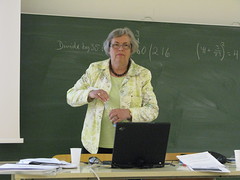
In Norway, there has been published a book on the first Norwegian mathematics (arithmetic) textbook: Tyge Hanssøn’s “Arithmetica Danica” from 1645. While the author (Geir Botten) has done lots of work on this book, he has not done research on the influences of the textbook (as far as I know). It would surely be interesting to see the results of such a study at one point.
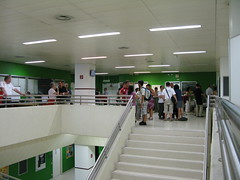 coffee break area
coffee break areaThe evening program was again oral presentations. Again, I was chairing (or cheering). There were three talks: Oscar Abdounur talked about the University of Sao Paulo, and how the invitation of European scholars to the university influenced it. Andreas Christiansen (whose name was terribly mispronounced by the chair – it’s a surprise that Christiansen (not Christensen) managed to speak after such an insult) spoke about Bernt Michael Holmboe’s textbooks and in particular how the concept of irrational number was presented in different editions, compared to how mathematicians elsewhere defined irrational numbers. Thirdly, Nuno Dias talked about the Portugese mathematics education, in particular after the Jesuits (who controlled Portugese education) were expelled in 1759.
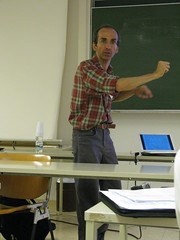

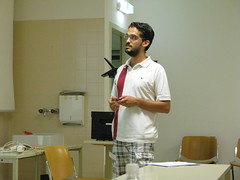




No comments:
Post a Comment